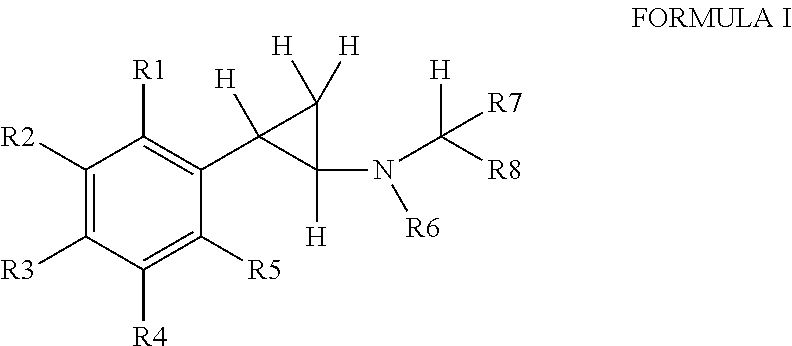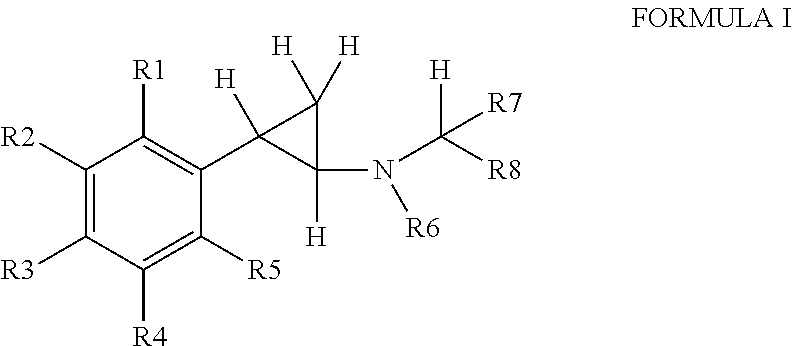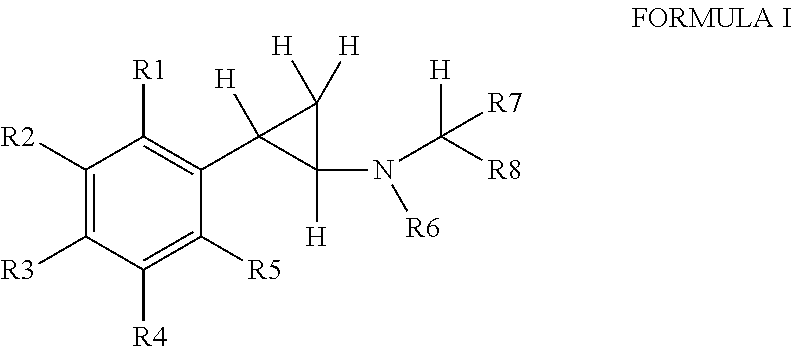Phenylcyclopropylamine derivatives and their medical use
a technology of phenylcyclopropylamine and derivatives, applied in the field of phenylcyclopropylamine derivatives, can solve the problems of a new health crisis facing industrialized nations, a tremendous economic burden on national health systems, and cancer is deadly
- Summary
- Abstract
- Description
- Claims
- Application Information
AI Technical Summary
Benefits of technology
Problems solved by technology
Method used
Image
Examples
example 1
(trans)-N-(4-fluorobenzyl)-2-phenylcyclopropanamine
[0419]
[0420]A mixture of (trans)-2-phenylcyclopropanamine hydrochloride (0.25 g, 1.50 mmol) and 4-fluorobenzaldehyde (0.18 mL, 1.65 mmol) in CH2Cl2 (8 mL) and water (0.5 mL) was vigorously stirred at room temperature for 10 min. Then, NaBH(OAc)3 (0.41 g, 1.95 mmol) was slowly added and stirring continued for 1.5 h. The reaction mixture was washed with an aqueous saturated solution of NaHCO3 (10 mL), the organic layer was dried over anhydrous Na2SO4, filtered and, after removal of the solvent, the residual oil was purified by column chromatography on silica gel (3% MeOH / CH2Cl2) affording 0.18 g of N-(4-fluorobenzyl)-N-[(trans)-2-phenylcyclopropyl]amine [Rf=0.5 (5% MeOH / CH2Cl2), colorless oil, 49% yield].
example 2
(trans)-N-(4-fluorobenzyl)-2-phenylcyclopropanaminium chloride
[0421]
[0422]2 M ethereal solution of HCl (0.24 mL, 0.47 mmol) was slowly added to a solution of N-(4-fluorobenzyl)-N-[(trans)-2-phenylcyclopropyl]amine (95 mg, 0.39 mmol) in dry Et2O (10 mL) cooled at −78° C., and allowed to reach room temperature. After 10 min the white precipitate was allowed to settle and Et2O was decanted, the solid was washed with Et2O (10 mL) and vacuum dried, rendering 90 mg of N-(4-fluorobenzyl)-N-[(trans)-2-phenylcyclopropyl]amine hydrochloride (white solid, 83% yield).
[0423]1H-NMR (MeOD, 250 MHz, δ): 7.59-7.49 (m, 2H, ArH); 7.34-7.05 (m, 7H, ArH); 4.38 (s, 2H, CH2); 3.02-2.93 (m, 1H, CH); 2.52-2.40 (m, 1H, CH); 1.58-1.31 (m, 2H, CH2).
example 3
4-(((trans)-2-phenylcyclopropylamino)methyl)benzonitrile
[0424]
[0425]A mixture of (trans)-2-phenylcyclopropanamine hydrochloride (0.25 g, 1.50 mmol) and 4-cyanobenzaldehyde (0.22 g, 1.65 mmol) in CH2Cl2 (8 mL) and water (0.5 mL) was vigorously stirred at room temperature for 10 min. Then, NaBH(OAc)3 (0.41 g, 1.95 mmol) was slowly added and stirring continued for 1.5 h. The reaction mixture was washed with an aqueous saturated solution of NaHCO3 (10 mL), the organic layer was dried over anhydrous Na2SO4, filtered and, after removal of the solvent, the residual oil was purified by column chromatography on silica gel (1% MeOH / CH2Cl2) affording 0.07 g of 4-({[(trans)-2-phenylcyclopropyl]amino}methyl)benzonitrile [Rf=0.6 (5% MeOH / CH2Cl2), colorless oil, 19% yield].
PUM
| Property | Measurement | Unit |
|---|---|---|
| temperature | aaaaa | aaaaa |
| pH | aaaaa | aaaaa |
| volume | aaaaa | aaaaa |
Abstract
Description
Claims
Application Information
 Login to View More
Login to View More - R&D
- Intellectual Property
- Life Sciences
- Materials
- Tech Scout
- Unparalleled Data Quality
- Higher Quality Content
- 60% Fewer Hallucinations
Browse by: Latest US Patents, China's latest patents, Technical Efficacy Thesaurus, Application Domain, Technology Topic, Popular Technical Reports.
© 2025 PatSnap. All rights reserved.Legal|Privacy policy|Modern Slavery Act Transparency Statement|Sitemap|About US| Contact US: help@patsnap.com



